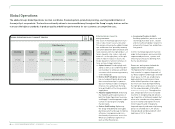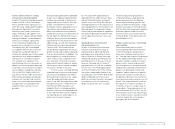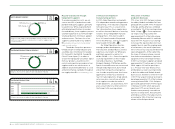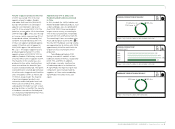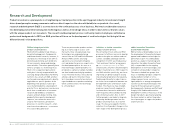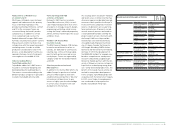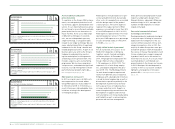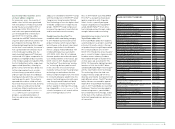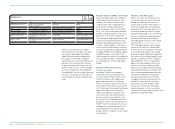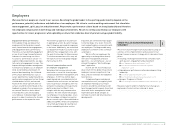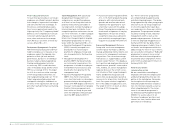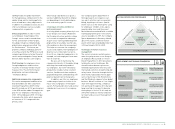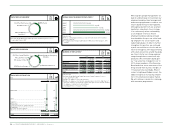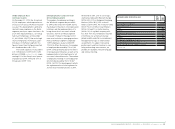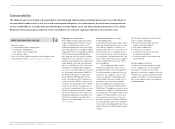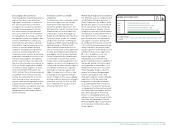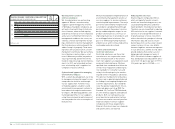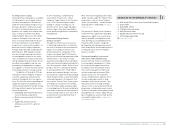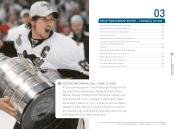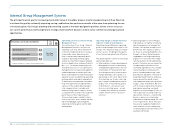Reebok 2009 Annual Report Download - page 102
Download and view the complete annual report
Please find page 102 of the 2009 Reebok annual report below. You can navigate through the pages in the report by either clicking on the pages listed below, or by using the keyword search tool below to find specific information within the annual report.
Fit for today and tomorrow
To reach their personal best, our Group’s
employees are offered training to build on
their strengths, improve their technique
and overcome their own challenges. In
this process, joining individual aspira-
tions to our organisational needs is the
highest priority. Our “Competency Model”
defines a set of competencies to ensure
consistent and transparent perform-
ance, talent and succession manage-
ment. We focus our efforts on three key
success drivers see 01.
Performance Management: Our global
PEP (Performance Evaluation and Plan-
ning) tool enables us to measure all our
employees against the required com-
petencies of their job level and their
performance, but also to set individual
business targets and plan appropriate
training and development activities
as necessary. PEP is used in business
units of the adidas Group and the online
PEP has a coverage of 56%. The target
for 2010 is to reach an online coverage
of 70% Group-wide. Furthermore, we
offer targeted training under our “Fit for
Today” programme (behavioural and
managerial training) for individuals on
all levels of the organisation and we sup-
port other team performance-enhancing
activities.
Talent Management: With specifically
designed talent management tools
and processes, we identify employees
at all levels of our Group who have the
potential to become future leaders in
our organisation. Actively managing our
internal talent pool contributes to our
competitive position and ensures that we
are “fit for tomorrow”. In order to prepare
employees for new and more complex
future roles, they participate in targeted
development programmes for various
levels within the organisation see 02:
Executive Development Programme
(EDP): A centrally managed cross-
brand and cross-functional pro-
gramme for employees Group-wide
who show potential for the Executive
Level.
Management Development Pro-
gramme (MDP): Run decentrally by
our local market organisations, this
programme is tailored for employees
from different functional areas and
brands who show potential for the
management level.
Business Management Programme
(BMP): A 24-month international
cross-functional and cross-brand pro-
gramme aiming at attracting profes-
sionals with MBA degrees and three to
five years’ work experience to prepare
them for future management posi-
tions within our Group. At year-end
2009, five employees were participat-
ing in the BMP globally (2008: 7).
Functional Trainee Programme (FTP):
A 12- to 18-month programme giving
graduates with international back-
grounds and excellent educational
credentials the opportunity to start
a functional career with the adidas
Group. The programme comprises six
three-month assignments in varying
departments. At least one of these
assignments takes place abroad. At
year-end 2009, we employed 39 par-
ticipants in our global FTP (2008: 29).
Succession Management: We have a
Group-wide succession management
system in place that helps us identify,
manage and develop internal talents and
successors for management and execu-
tive positions. The succession manage-
ment process is supported by a system
solution called “Horizon”. This database
hosts position and employee data related
to performance, potential, career aspira-
tions, mobility, etc. Senior management
regularly discusses the current succes-
sion situation of their respective depart-
ments and identifies key players and
talents that are designated or potential
successors for all positions from Director
level. Our system solution is applied in
53% of the adidas Group business units.
The target for 2010 is to reach an online
coverage of 70% Group-wide.
98 GROUP MANAGEMENT REPORT – OUR GROUP Employees
Our “Fit For Tomorrow” programmes
are complemented by apprenticeship
and internship programmes. The adidas
Group apprenticeship offers young people
who want to join our Group straight out
of school the opportunity to gain busi-
ness experience in a three-year rotation
programme. The programme includes
vocational training in retail, industrial
management and IT as well as inte-
grated study programmes. At the end
of 2009, we employed 58 apprentices in
Germany (2008: 54). Our global intern-
ship programme gives students three to
six months’ work experience within the
adidas Group. For “best-of-class” interns,
we successfully continued our “ReBound”
programme to remain in close contact
with them after their internship and fos-
ter potential future employment. At the
end of 2009, we employed 331 interns in
Germany (2008: 396).
Performance-driven
remuneration system
We are committed to rewarding our
employees with effective compensation
and benefit programmes that are com-
petitive in the marketplace. Remunera-
tion throughout the Group comprises
fixed and variable monetary compensa-
tion, non-monetary rewards, as well as
other intangible benefits. The corner-
stone of our rewards programme is
our Global Salary Management System
(GSMS). It is used as a basis to set
the value of employees’ positions and
salaries in a clear, market-driven and
performance-oriented way.


